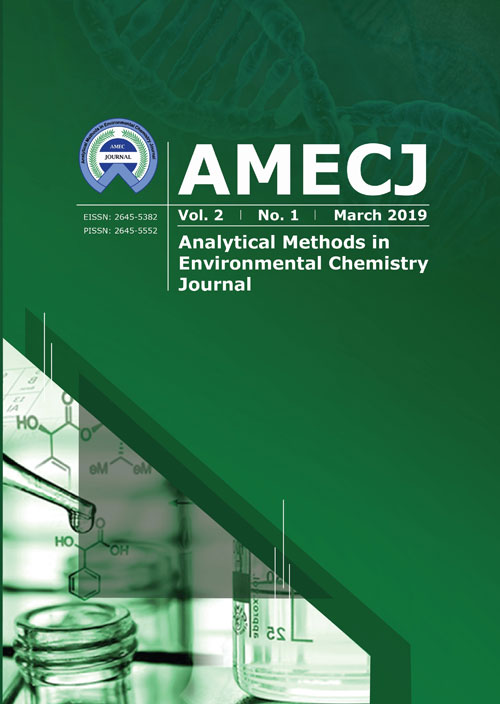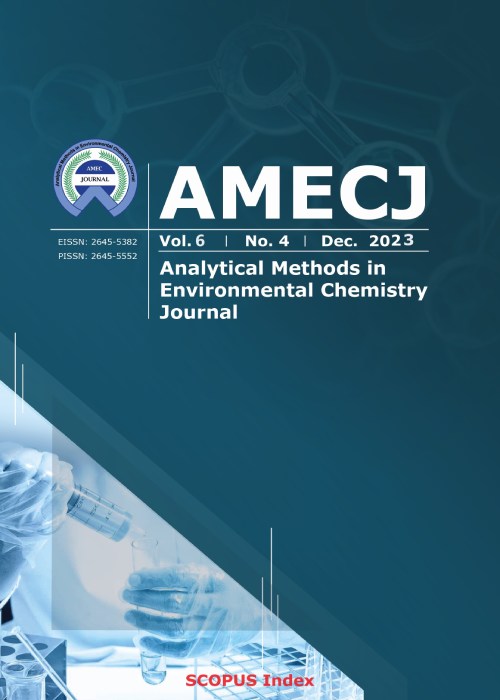فهرست مطالب

Analytical Methods in Environmental Chemistry Journal
Volume:2 Issue: 1, Mar 2019
- تاریخ انتشار: 1398/02/03
- تعداد عناوین: 8
-
Pages 5-14Chronic effect of manganese exposure to humans caused the dysfunction of nervous system. An applied sorbent based on hydrophobic ionic liquid passed on mesoporous silica nanoparticles was used for adsorption/removal of manganese dust (Mn) from workplace air by solid phase adsorption method. In bench scale set up, 5 mL of standard solution of nitrate and oxide of Mn (0.2-5 mg L-1) was used for generation of manganese dust in pure air by drying procedure, and then was passed through column of IL/MSNPs by SKC pump with flow rate of 200-500 mL min-1 by SKC pump. The Mn particles separated from column of IL/MSNPs by irrigation of nitric acid solution before determined by F-AAS/ET-AAS. In optimized conditions, the adsorption capacity of MSNPs and IL/MSNPs for Mn removal from air in batch system (1 Li) was obtained 118.5 mg g-1 and 216.2 mg g-1, respectively.Keywords: Manganese dust, Air pollution, Ionic liquid, Mesoporous silica nanoparticles, Solid phase adsorption method
-
Pages 15-32Aluminum is a toxic metal and causes pollution in soil, water, and air. Afterward, a lot of patients suffer renal failure due to the accumulation of aluminum in the tissues of kidneys. Also, a high concentration of aluminum in plants tissues makes agricultural food toxic. Therefore, measuring aluminum in water, soil, air, human organs, tissues of plants and each food (or agricultural product is so necessary for protecting human health. Also, the effect of some parameters such as pH and temperature on decrease or increase in the amount of aluminum in water and other samples are stated. In this review, the analytical methods such as fluorimetric, ICP-MS, colorimetric, graphite furnace/flame atomic absorption spectrometry, etc. which have been applied for measuring the amount of aluminum (especially ) in environmental and human biological samples are assesseKeywords: Analytical, Bioanalytical methods, Aluminum, Human, Environment samples, Toxicity, Measuring
-
Pages 33-42The present study describes a method based on static headspace- extraction (HS) followed by gas chromatography/ mass spectrometry (GC/MS) for the qualitative and quantitative analysis of Methyl tert-buthyl ether (MTBE) and formaldehyde (HCHO) in human blood and water samples. Cytochrome P4502A6 has important role for converting of MTBE to tert-butyl alcohol (TBA) and HCHO. To enhance the extraction capability of the HS, extraction parameters such as extraction temperature, extraction time, the ratio of headspace volume to sample volume and sodium chloride concentration have been optimized.Keywords: Formaldehyde, MTBE, Static headspace-GC-MS, Oil refining wastewaters, biological matrices
-
Pages 43-48A solid-phase extraction method based on multi-walled carbon nanotubes (MWCNTs) was applied for the preconcentration of L-tryptophan prior to its spectrofluorometric determination. Due to the high surface area of MWCNTs, satisfactory concentration factor and extraction recovery can be achieved with only 10 mg MWCNTs in 5 min. The effects of pH, sorbent amount, eluent type and time on the recovery of the analyte were investigated. Under the optimum conditions, the detection limit for L-tryptophan was 8.9 ng mL−1. The precision of the method, evaluated as the relative standard deviation obtained by analyzing of 10 replicates, was 2.6%. The practical applicability of the developed method was examined using wheat and barley samples.Keywords: L-tryptophan, Solid-phase extraction, Multi-walled carbon nanotubes, Bioanalysis, Spectrofluorometry
-
Pages 49-54In this study, 350 vehicles in 20 different models were examined in one of Tehran’s Automobile Technical Inspection Centers. The laboratory tests indicate that longtime exposure to benzene has destructive effects on the blood cells, especially the bone-marrow cells. The concentration levels of benzene caused by the emission of gasoline vapors from fuel tanks doors were measured by PhoCheck EX5000 during a 5 to 15-minute interval for each car. The results indicate that the concentration of benzene caused by the emission of gasoline vapors from the fuel tanks door of the domestic cars was 10 times higher than the imported cars. In most of the imported cars, the amount of benzene in the three measured areas was negligible. This is due to the use of new technology and adaptation of strict environmental standards by the manufacturing country.Keywords: Volatile Organic Compounds, Benzene emission, PhoCheck, Domestic cars, Analysis of benzene in Air
-
Pages 55-62In this study, soils, well waters, drinking waters, and waste water in the Isfahan industrial area were sampled in spring and summer 2018. In 8 points of industrial zone, important toxic heavy metals such as, lead (Pb), Cobalt (Co), Nickel (Ni), Chromium (Cr), and Cadmium (Cd) were sampled from surface soil (up to 2 m), well/drinking waters and waste water. After sample preparation with micro-wave digestion technique, the concentration of heavy metals was determined by electro-thermal atomic absorption spectrometry (ET-AAS). According to the well water analysis, the mean concentration of Cr, Ni, Co, Cd, and Pb in well water were 95 μg L-1, 146 μg L-1, 185 μg L-1, 12 μg L-1, and 11 μg L-1, respectively. In well water, the concentrations of Cd, Ni, Cr and Co were found much higher than Pb in comparison with the references of World Health Organization (WHO).Keywords: Heavy Metals, Environmental Pollution, Waters-Soils, Electro-thermal Atomic Absorption Spectrometry
-
Pages 63-72High levels of arsenic in the effluent are a major concern of human, and the removal of it from the wastewater is hard and costly. The most common techniques for removal of arsenic are membrane separation, ion exchange, oxidation, and coagulation. The active carbon is used as the most common arsenic adsorbent in wastewater treatment processes, this study has been considered as the main adsorbent and attempted to improve its surface properties by graphene nanosheets. Thus, by adding graphene (4.5%w) to the carbon structure, its porosity increases, and the ion exchange behavior and surface load are corrected. In this research, the effects of time process, concentration of arsenic, and adsorbent are evaluated in different pH values. It has been observed that the maximum adsorption of arsenic is 91.8%; in addition, when graphene is used, the rate of absorption of Arsenic has increased about 5.2%, and the process time is shortened.Keywords: Arsenic, Graphene, Activated carbon, Adsorption, Acidity of wastewater
-
Pages 73-86A new sorbent based on mixture of bismuth oxide-fullerene nanoparticles (Bi2O3-NF) was used for degradation/removal of toluene from workplace and artificial air by UV-photocatalytic oxidation method (UV-PCOM). By set up of pilot, standard gas of toluene was generated with difference concentrations, and then was passed through UV lamp-glass quartz cell accessory(UV-GQC) by SKC pump at optimized flow rate. Following the UV irradiation, the electrons and holes can undergo redox reactions with toluene on the Bi2O3 surface that lead to the formation of toluene intermediates and toluene. Toluene and intermediates was physically and radically absorbed on the 200 mg of NF at room temperature and then, desorbed from it at 185 OC before determined by GC/FID. In optimized conditions, the adsorption capacity and removal efficiency of NF were obtained 212 mg g-1 and more than 95%, respectively.Keywords: Toluene, Air removal, Bismuth oxide nanoparticles, bulky fullerene nanoparticles, UV-photocatalytic, Solid gas phase extraction


